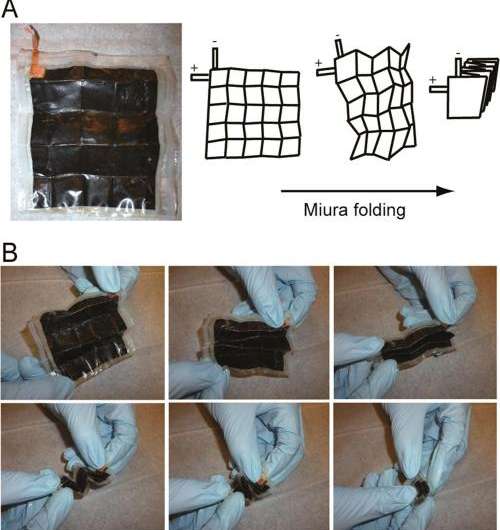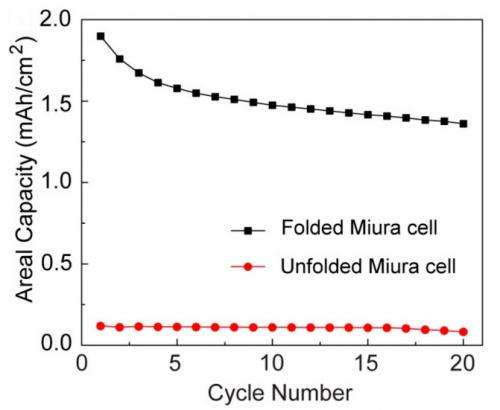October 8, 2013 feature
Folding batteries increases their areal energy density by up to 14 times

(Phys.org) —By folding a paper-based Li-ion battery in a Miura-ori pattern (similar to how some maps are folded), scientists have shown that the battery exhibits a 14x increase in areal energy density and capacity due to its smaller footprint. Paper-based batteries are already attractive due to their low cost, roll-to-roll fabrication methods, and flexibility. The advantages of folding them into smaller sizes adds to these features and could lead to high-performance batteries for various applications.
The researchers, Qian Cheng, et al., from Arizona State University, have published a paper on folding paper-based Li-ion batteries in a recent issue of Nano Letters.
"Foldable batteries may be useful for powering devices that have limited space on board," coauthor Candace Chan, Assistant Professor of Materials Science and Engineering at Arizona State University, told Phys.org. "Furthermore, with the development of foldable paper-based electronics demonstrated by other research groups recently, a battery that also can be folded may become important for integration of the power source and other components into a single, entirely foldable device."
In the current study, the scientists used Li-ion batteries made of carbon nanotube (CNT) ink as the current collectors; conventional lithium-based powders as the electrodes; and thin, porous KimwipesTM as the paper substrates. The researchers also added a polyvinylidene difluoride (PVDF) coating to improve adhesion of the CNT ink to the paper substrates. The final batteries showed good conductivity and—after an irreversible capacity loss after the first cycle—a relatively stable capacity.
The researchers experimented with simple folding of the papers in half and the more complicated Miura-ori folding pattern. Using the simple folding-in-half pattern, the researchers found that one, two, and three folds results in increasing the areal energy density and capacity by 1.9, 4.7, and 10.6 times compared to a planar battery. The Miura-ori pattern could fold the paper even more efficiently: folding a 6 cm x 7 cm battery into a stack of 25 layers increases the areal energy density and capacity by 14 times and gives a total area of just 1.68 cm2.

"We used 'areal' density to show that the energy density per foot print area is increased," Chan explained. "This is different from the gravimetric energy density, since the amount of mass in the batteries does not change when it is folded and unfolded. So saying 'areal' density makes it clearer which density we are referring to."
Overall, the batteries folded in the simple pattern maintained an electrochemical performance that was similar to the planar batteries. The Coulombic efficiencies for the folded batteries were even higher than those for the unfolded batteries, which may be due to improved contact between the electrode materials and the CNTs after folding. SEM imaging showed some delamination of the CNT layer at the vertex corresponding to the intersection of two perpendicular folds; however, no further delamination or cracking was observed away from the intersection.
The batteries folded in the Miura-ori pattern had slightly reduced performance compared to planar batteries, including a lower discharge capacity and specific capacity. The researchers think these losses may be due to delamination at the intersections of perpendicular folds, since these batteries contain 16 vertices. To prevent short-circuiting on the batteries, the researchers used a flexible insulating thin-film, Parylene-C, between layers.
The results offer a first glimpse of the potential of using folding to increase the areal energy density and capacity of Li-ion batteries. In the future, advances in geometric folding algorithms, computational tools, and robot manipulation could lead to more complex folding patterns and allow the batteries to be manufactured on large scales for commercial applications.
"There are endless possibilities for using folding and origami concepts to impart new shapes, geometric design, and new functionalities to paper-based energy storage devices not possible before," Chan said.
More information: Qian Cheng, et al. "Folding Paper-Based Lithium-Ion Batteries for Higher Areal Energy Densities." Nano Letters. DOI: 10.1021/nl4030374
Journal information: Nano Letters
© 2013 Phys.org. All rights reserved.





















